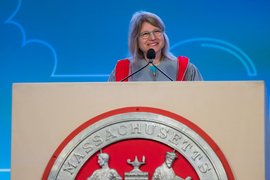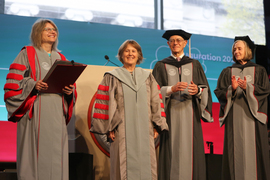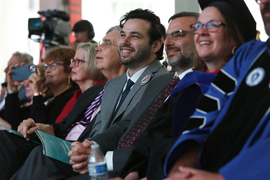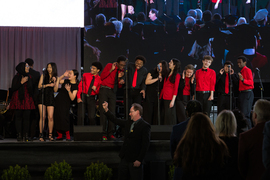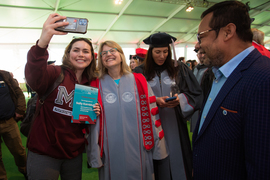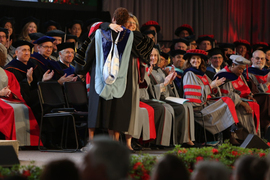Sally Kornbluth made a resounding call today for the entire MIT community to join together and address the “global crises” of the current era, including climate change, in her inaugural address as the Institute’s 18th president.
“I hope to inspire you to join us in something important and new,” Kornbluth said in remarks delivered to a large audience under a massive tent in Killian Court, the traditional location of inaugural ceremonies at MIT.
Heralding the Institute community’s “signature ability to foster the very best in fundamental research and harness it to confront society’s hardest problems,” Kornbluth emphasized that many of those challenges would require new research, new forms of collaboration, and renewed efforts to take timely action in society.
“As humanity struggles with so many interlocking global crises, it has never needed the people of MIT more than it does now,” added Kornbluth, whose tenure as Institute president began on Jan. 1.
The inauguration featured the theme “Curiosity Unbounded,” a motif Kornbluth has been developing during her presidency. Among the many attendees were delegates from 79 different universities, learned societies, and other organizations. In introductory remarks, Diane Greene SM ’78, chair of the MIT Corporation, observed that the inauguration “celebrates and solemnizes the beginning of a new era.” Along with Greene, MIT’s two previous presidents, Susan Hockfield and L. Rafael Reif, participated in the formal investiture of the presidency upon Kornbluth.
Kornbluth was introduced by Valerie Sheares Ashby, president of the University of Maryland at Baltimore County, who praised Kornbluth’s values, integrity, and leadership acumen.
“She embodies exactly what higher education needs in leadership at this critical moment in the nation and the world: clarity, vision, courage, and humility,” said Sheares Ashby, a former colleague of Kornbluth at Duke University. She called Kornbluth “a brilliant scientist, scholar, and teacher,” adding, “This is who she is every day.”
Scaling the peaks, together
Kornbluth’s address was the keystone of two days of inauguration events and festivities on the MIT campus, which on Saturday featured a campus-wide street fair, including exhibits, dance and music performances, games, and carnival rides, followed by an evening concert at Kresge Auditorium. Earlier on Monday, the Institute also hosted a symposium titled “Where Big Ideas Come From — And Why They Matter,” featuring a panel discussion by MIT faculty from a variety of disciplines. The day closed with an evening performance by singer-songwriters Marc Cohn and Shawn Colvin in Kresge Auditorium.
Kornbluth’s inaugural address covered a range of matters while connecting them back to the idea that higher education can best realize its potential for society as a collaborative enterprise. Speaking on the role of university leaders, Kornbluth observed how important it was to improve the quality of life for students, develop campus staff, and support a diverse faculty, among other things.
Higher education leaders, she added, must find “the right resources and the right talent” for their institutions, “clear away bureaucratic boulders,” and “scout out the best routes for scaling the toughest peaks,” when it comes to the university enterprise of discovery and innovation.
“If we do those three things right, we create an environment in which every individual has the freedom and support to flourish and grow,” Kornbluth said,
“and in which we all have a sense of community, connection, and shared purpose — those human bonds that allow us to go farther and faster together than any of us could go alone.”
Listening and learning
Since joining MIT from Duke University, where she served as provost, Kornbluth has been engaged in a campus-wide listening tour, receiving feedback from many in the MIT community. In these circumstances, Kornbluth noted, “for me to bring forth today some detailed strategic vision [about MIT] would be arrogant in the extreme.”
However, Kornbluth did outline an overall vision for MIT 10 years from now. In 2033, she suggested, it is reasonable to imagine that Institute faculty and students will have “unraveled daunting intellectual puzzles, from mathematics to materials science, urban planning to economics, neuroscience to nuclear engineering, physics to philosophy to finance,” while also having “helped humanity come to grips with the tectonic forces of artificial intelligence, containing its risks and harnessing its power for good.”
A decade from now, she added, she envisions MIT having introduced a new core curriculum, and witnessed a “new flowering of the humanities and the arts at MIT, the fields that tell us what it means, and why it matters, that we are human beings — fields that must be equal partners in inventing a just, humane, and equitable future.”
Kornbluth suggested that by 2033 we will have witnessed new links between engineering and biology that will constitute “the future of healing” and will have “made Greater Boston the hub of the next biotech revolution too.” And she envisioned the Met Warehouse as “a bustling hub of making and design,” while entrepreneurship-driven efforts continue to aid society.
In concert with all of this, Kornbluth suggested, MIT will be a success in 2033 if it “has truly become a place of inclusive excellence and enthusiastic diversity, where everyone feels that they matter, and they belong.”
Fighting climate change, with urgency
While Kornbluth cited a wide range of MIT endeavors, the subject she discussed at greatest length was climate change, which she called “the greatest scientific and societal challenge of this or any age.”
Kornbluth emphasized that on her campus listening tour, members of the MIT community had “above all, and most urgently” expressed the need for the Institute to continue to “marshal a bold, tenacious response to the run-away crisis of climate change,” a line that received a healthy round of applause from the audience.
As she noted, MIT has played a key role in many landmark advances in science and technology previously, including the LIGO program that detected gravitational waves, the Human Genome Project, the Apollo program that put humans on the moon, and the Rad Lab, which helped develop radar during World War II.
“To meet the challenge of climate, it’s time for the people of MIT to engage in Rad-Lab-level thinking and commitment again,” Kornbluth said. “I want you, and I need you, to help me imagine what that should look like, and how it can succeed — the kind of grand creative enterprise in which the energy you release together is greater than what you each put in: a nuclear fusion of problem-solving and possibility.”
Kornbluth said she “would not presume” to outline all the forthcoming facets of MIT’s climate efforts, but said, “This is work we will do together, starting now. We need energy and expertise from every MIT school and the college [of computing], from every lab and every center, from every member of the faculty — and from every one of you.”
She added: “I am absolutely certain that this urgent project is the singular effort that needs our shared attention. We can only meet this crisis if we’re brave enough to lower our shields, reach out, and work together in new ways.”
Curiosity, collaboration, and community
Prior to joining MIT, Kornbluth served for over eight years as provost of Duke University, where she had been on the faculty since 1994. Kornbluth received her first undergraduate degree from Williams College, then earned a BA in genetics from Cambridge University followed by a PhD from Rockefeller University, and served as a postdoc at the University of California at San Diego before joining Duke.
In her speech, Kornbluth reflected further on the value of curiosity. As she defined it, curiosity is “the passion to understand how things work and why, and how they can work better.” However, she made clear that curiosity’s value does not only lie in spurring intellectual reflection, experiments, and other forms of laboratory-based research.
Curiosity is also a quality of great societal value, she said. It is how people can better appreciate each other, whatever differences may lie between them.
“Importantly, curiosity is also the one and only path to understanding one another — to empathy and appreciation and mutual respect,” Kornbluth observed. “In effect, curiosity is the indispensable first step in both collaboration and community.”
“I want you to feel part of this”
The inauguration ceremony included prelude music from MIT Ceremonial Brass and a presentation of the flags by the MIT Police Honor Guard, along with a performance of “America the Beautiful.” MIT Ceremonial Brass played the triumphal march from “Aida,” to accompany the inaugural procession.
Thea Keith-Lucas, chaplain to the Institute, gave the invocation. Jodie-Marie Fernandes ’09 performed a spectacular rendition of the national anthem, accompanied on piano by Mi-Eun Kim. There was also a musical interlude before Kornbluth’s remarks, as Ricky Richardson and Friends performed “Chase Fire,” written by Richardson, a member of the Class of 2012.
At the end of the ceremony, The Chorallaries of MIT a capella group performed the school song, “In Praise of MIT,” and the MIT Ceremonial Brass played recessional music.
Kornbluth closed with another forthright call for everyone in the MIT community to feel involved and central to the Institute’s vital efforts, whether on climate change or in any other field of endeavor.
“Whatever your role at MIT, I want you to feel part of this,” Kornbluth said. “Every member of this community is an essential part of the ecosystem that makes the breakthroughs possible. I want us all to take pride in how this community comes together to meet the existential challenges of humankind. I know I will take great pride in joining you.”
